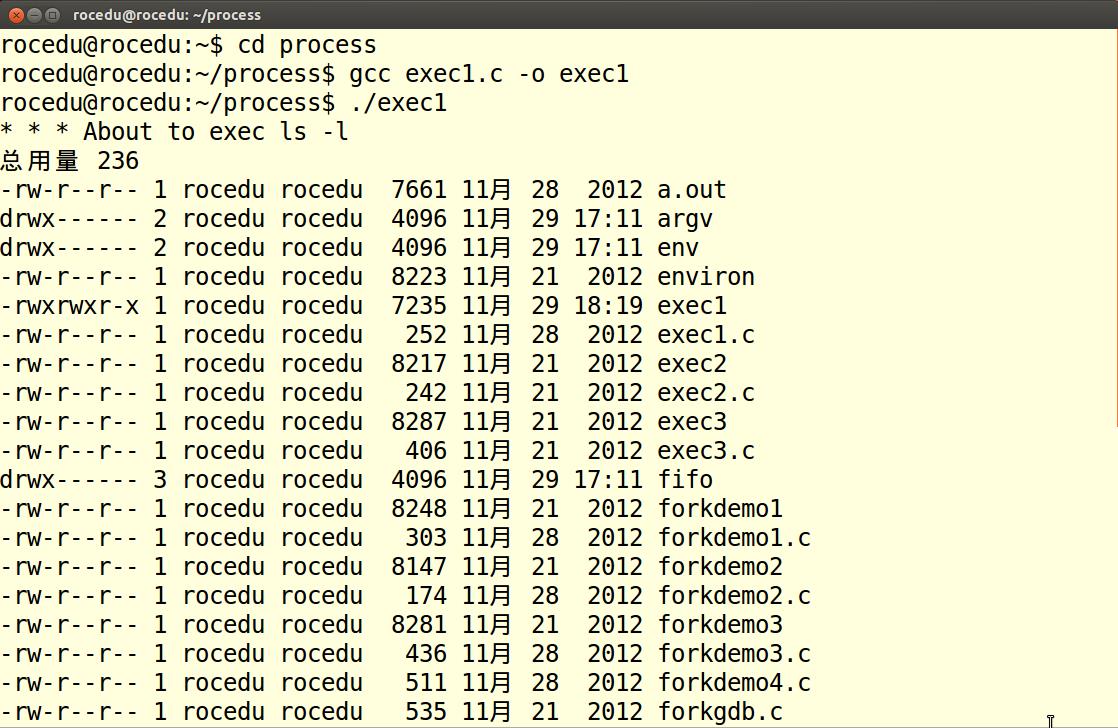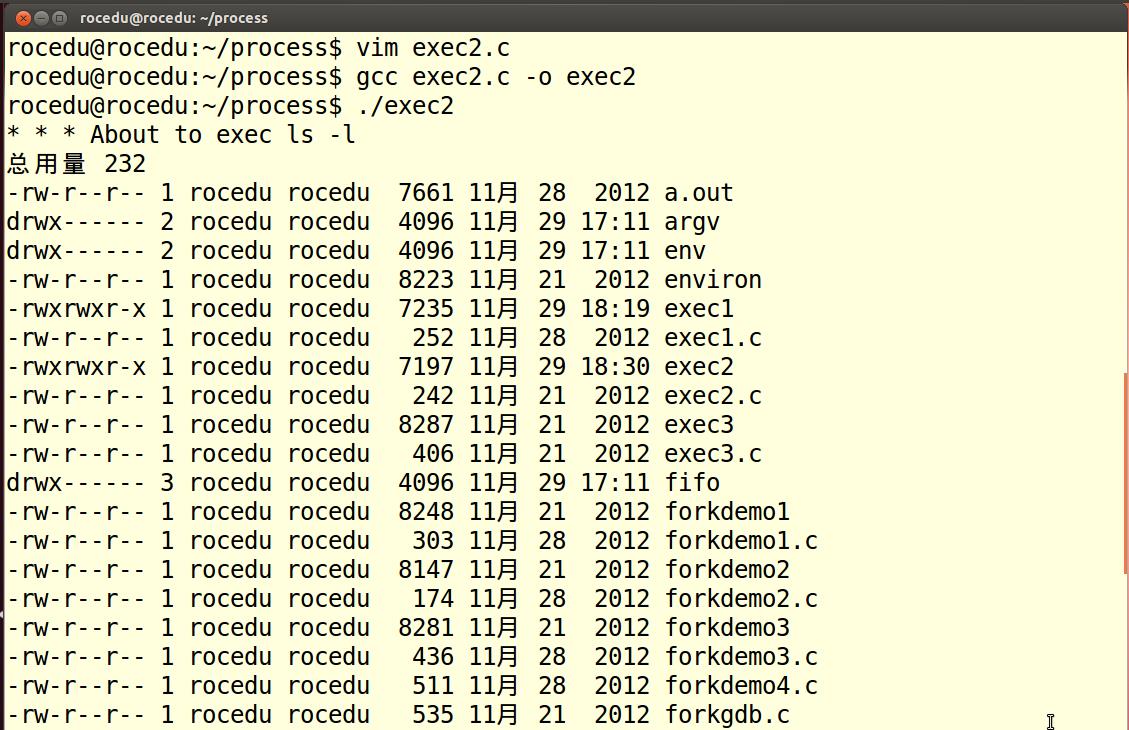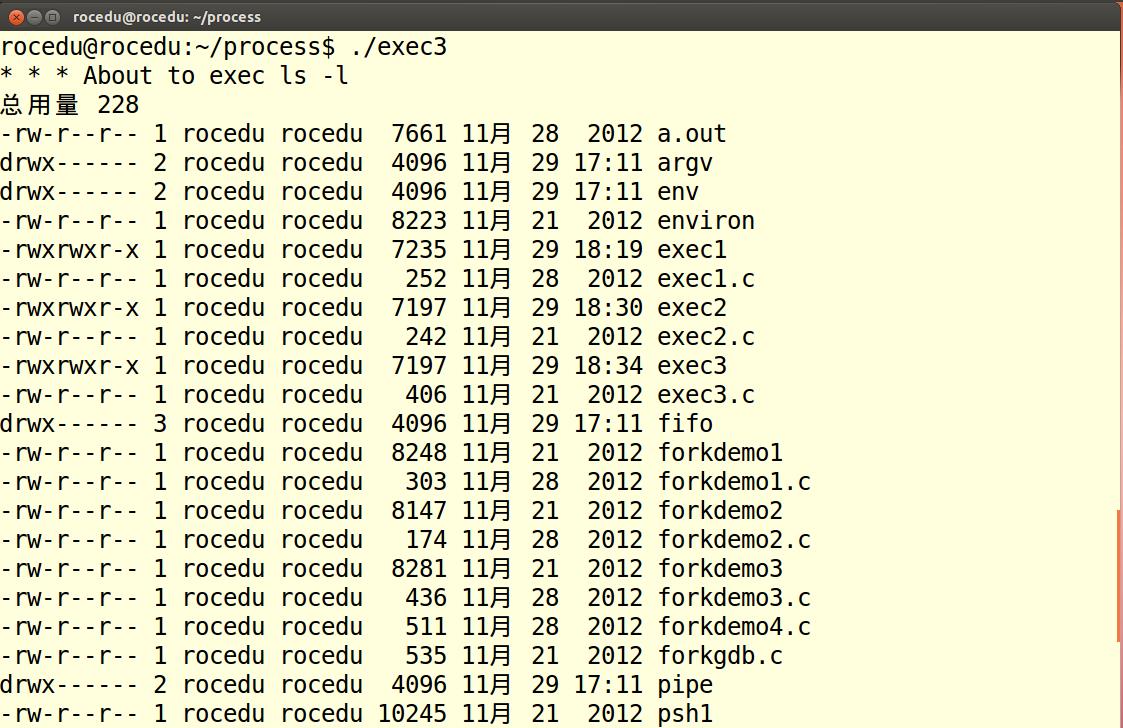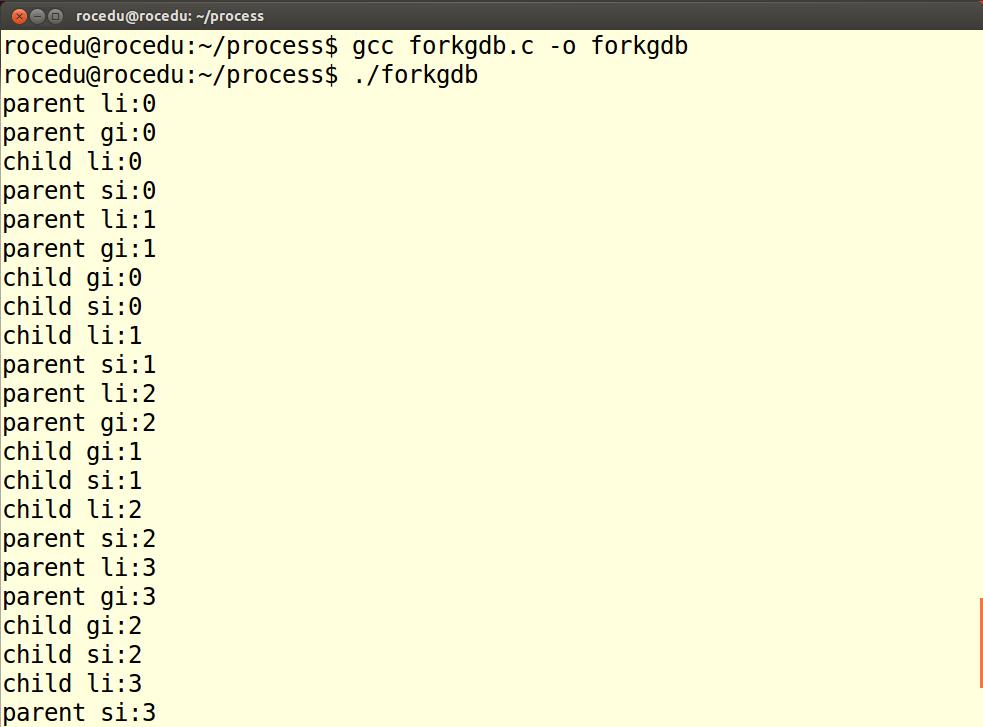exec1
#include <stdio.h>
#include <unistd.h>
int main()
{
char *arglist[3];
arglist[0] = "ls";
arglist[1] = "-l";
arglist[2] = 0 ;//NULL
printf("* * * About to exec ls -l
");
execvp( "ls" , arglist );
printf("* * * ls is done. bye");
return 0;
}
其中:
execvp(执行文件)
-
相关函数:
fork,execl,execle,execlp,execv,execve -
表头文件:
#include<unistd.h> -
定义函数:
int execvp(const char *file ,char * const argv []); 返回:如果执行成功则函数不会返回,执行失败则直接返回-1,失败原因存于errno中。 -
函数说明:
execvp()会从PATH 环境变量所指的目录中查找符合参数file 的文件名,找到后便执行该文件,然后将第二个参数argv传给该欲执行的文件。
运行结果:

exec2
#include <stdio.h>
#include <unistd.h>
int main()
{
char *arglist[3];
arglist[0] = "ls";
arglist[1] = "-l";
arglist[2] = 0 ;
printf("* * * About to exec ls -l
");
execvp( arglist[0] , arglist );
printf("* * * ls is done. bye
");
}
exec2与exec1的不同是exevp中第一个参数不一样,exec1是ls,exec2是arglist[0]。
运行结果:

exec3
#include <stdio.h>
#include <unistd.h>
int main()
{
char *arglist[3];
char*myenv[3];
myenv[0] = "PATH=:/bin:";
myenv[1] = NULL;
arglist[0] = "ls";
arglist[1] = "-l";
arglist[2] = 0 ;
printf("* * * About to exec ls -l
");
execlp("ls", "ls", "-l", NULL);
printf("* * * ls is done. bye
");
}
其中:
execlp()函数
属于exec()函数族(exec()族函数用一个新的进程映像替换当前进程映像)它是execve(2)函数的前端
-
相关函数:fork,execl,execle,execv,execve,execvp
-
头文件:
#include<unistd.h> -
定义函数:
int execlp(const char * file,const char * arg,....); 返回:如果执行成功则函数不会返回,执行失败则直接返回-1,失败原因存于errno 中。 -
函数说明:
execlp()会从PATH 环境变量所指的目录中查找符合参数file的文件名,找到后便执行该文件,然后将第二个以后的参数当做该文件的argv[0]、argv[1]……,最后一个参数必须用空指针(NULL)作结束。如果用常数0来表示一个空指针,则必须将它强制转换为一个字符指针,否则将它解释为整形参数,如果一个整形数的长度与char * 的长度不同,那么exec函数的实际参数就将出错。如果函数调用成功,进程自己的执行代码就会变成加载程序的代码,execlp()后边的代码也就不会执行了.
运行结果:

这个代码指定了环境变量,然后依然执行了ls -l指令,成功后没有返回,所以最后一句话不会输出。运行结果同exec1.
forkdemo1
#include <stdio.h>
#include<sys/types.h>
#include<unistd.h>
int main()
{
int ret_from_fork, mypid;
mypid = getpid();
printf("Before: my pid is %d
", mypid);
ret_from_fork = fork();
sleep(1);
printf("After: my pid is %d, fork() said %d
",
getpid(), ret_from_fork);
return 0;
}
运行结果:

代码理解:先打印进程pid,然后fork生成子进程,休眠一秒后再次打印进程id,这时父进程打印子进程pid,子进程返回0.
forkdemo2
#include <stdio.h>
#include <unistd.h>
int main()
{
printf("before:my pid is %d
", getpid() );
fork();
fork();
printf("aftre:my pid is %d
", getpid() );
return 0;
}
调用两次fork,产生四个子进程,所以会打印四个aftre输出。
运行结果:

forkdemo3
#include <stdio.h>
#include <stdlib.h>
#include <unistd.h>
int main()
{
int fork_rv;
printf("Before: my pid is %d
", getpid());
fork_rv = fork(); /* create new process */
if ( fork_rv == -1 ) /* check for error */
perror("fork");
else if ( fork_rv == 0 ){
printf("I am the child. my pid=%d
", getpid());
exit(0);
}
else{
printf("I am the parent. my child is %d
", fork_rv);
exit(0);
}
return 0;
}
运行结果:

forkdemo4
#include <stdio.h>
#include <stdlib.h>
#include <unistd.h>
int main()
{
int fork_rv;
printf("Before: my pid is %d
", getpid());
fork_rv = fork(); /* create new process */
if ( fork_rv == -1 ) /* check for error */
perror("fork");
else if ( fork_rv == 0 ){
printf("I am the child. my pid=%d
", getpid());
printf("parent pid= %d, my pid=%d
", getppid(), getpid());
exit(0);
}
else{
printf("I am the parent. my child is %d
", fork_rv);
sleep(10);
exit(0);
}
return 0;
}
运行结果如下:

forkgdb
#include <stdio.h>
#include <stdlib.h>
#include <unistd.h>
int gi=0;
int main()
{
int li=0;
static int si=0;
int i=0;
pid_t pid = fork();
if(pid == -1){
exit(-1);
}
else if(pid == 0){
for(i=0; i<5; i++){
printf("child li:%d
", li++);
sleep(1);
printf("child gi:%d
", gi++);
printf("child si:%d
", si++);
}
exit(0);
}
else{
for(i=0; i<5; i++){
printf("parent li:%d
", li++);
printf("parent gi:%d
", gi++);
sleep(1);
printf("parent si:%d
", si++);
}
exit(0);
}
return 0;
}
运行结果:


父进程打印先打印两句parent,休眠一秒,再打印一句parent,子进程先打印一句child,休眠一秒,再打印两句child。两个线程并发执行,在一个线程休眠的一秒,另一个线程执行,并且线程之间相互独立互不干扰。
testbuf1:
#include <stdio.h>
#include <stdlib.h>
int main()
{
printf("hello");
fflush(stdout);
while(1);
}
testbuf2
#include <stdio.h>
int main()
{
printf("hello
");
while(1);
}
fflush(stdout):
在printf()后使用fflush(stdout)的作用是立刻将要输出的内容输出。
当使用printf()函数后,系统将内容存入输出缓冲区,等到时间片轮转到系统的输出程序时,将其输出。 使用fflush(out)后,立刻清空输出缓冲区,并把缓冲区内容输出。
testbuf3
#include <stdio.h>
int main()
{
fprintf(stdout, "1234", 5);
fprintf(stderr, "abcd", 4);
}
将内容格式化输出到标准错误、输出流中。
stderr -- 标准错误输出设备
stdout -- 标准输出设备 (printf(".."))
两者默认向屏幕输出。 但如果用转向标准输出到磁盘文件,则可看出两者区别。stdout输出到磁盘文件,stderr在屏幕。
运行结果:

waitdemo1
#include <stdio.h>
#include <stdlib.h>
#include <sys/types.h>
#include <sys/wait.h>
#include <unistd.h>
#define DELAY 4
void child_code(int delay)
{
printf("child %d here. will sleep for %d seconds
", getpid(), delay);
sleep(delay);
printf("child done. about to exit
");
exit(17);
}
void parent_code(int childpid)
{
int wait_rv=0; /* return value from wait() */
wait_rv = wait(NULL);
printf("done waiting for %d. Wait returned: %d
",
childpid, wait_rv);
}
int main()
{
int newpid;
printf("before: mypid is %d
", getpid());
if ( (newpid = fork()) == -1 )
perror("fork");
else if ( newpid == 0 )
child_code(DELAY);
else
parent_code(newpid);
return 0;
}
如果有子进程,则终止子进程,成功返回子进程pid。
运行结果:

waitdemo2
#include <stdio.h>
#include <stdlib.h>
#include <sys/types.h>
#include <sys/wait.h>
#include <unistd.h>
#define DELAY 10
void child_code(int delay)
{
printf("child %d here. will sleep for %d seconds
", getpid(), delay);
sleep(delay);
printf("child done. about to exit
");
exit(27);
}
void parent_code(int childpid)
{
int wait_rv;
int child_status;
int high_8, low_7, bit_7;
wait_rv = wait(&child_status);
printf("done waiting for %d. Wait returned: %d
", childpid, wait_rv);
high_8 = child_status >> 8; /* 1111 1111 0000 0000 */
low_7 = child_status & 0x7F; /* 0000 0000 0111 1111 */
bit_7 = child_status & 0x80; /* 0000 0000 1000 0000 */
printf("status: exit=%d, sig=%d, core=%d
", high_8, low_7, bit_7);
}
int main()
{
int newpid;
printf("before: mypid is %d
", getpid());
if ( (newpid = fork()) == -1 )
perror("fork");
else if ( newpid == 0 )
child_code(DELAY);
else
parent_code(newpid);
}
运行结果:

遇到的问题:
在testbuf1和testbuf2运行的不太懂。testbuf1运行出来打印一个hello,testbuf2运行出来也是打印一个hello。我把testbuf1中的"fflush(stdout);"标识为注释后,则什么都打印不出来。是为什么?